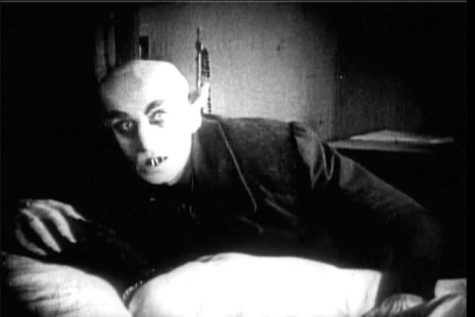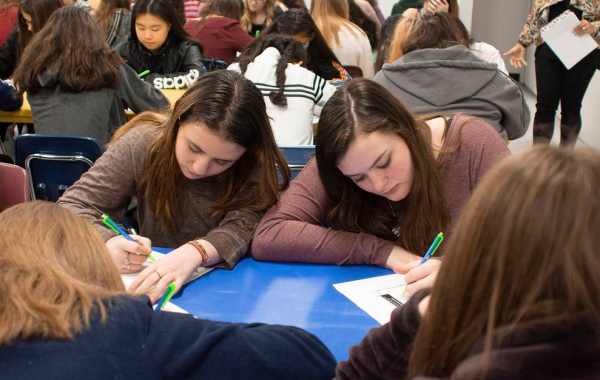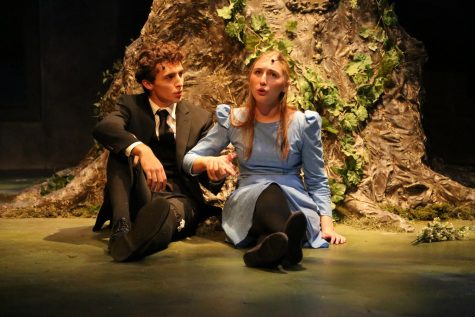Media Arts Hosts Narrative Showcase
Comet Yearbook
AV teacher Sean Gallagher presents student narratives at the KAHS Media Showcase in the PAC.
The Media Arts department put on a narrative showcase in the PAC on October 19th to share their short films that they have worked on tirelessly since August. The films were introduced by KAHS teacher, Mr. Gallagher, who expressed his pride in the hard work of his students over the past 3 months and the value of student film-making. The Showcase consisted of the first 2 KAHS episodes of the 2018-2019 school year, followed by 5 narrative productions all directed, produced, and acted by students in the KAHS class.
The KAHS episode, Austin High, Divided was the first film of the night and set the bar high. The film was produced by Ben Fremin, Miranda Gershoni, and St. John Requejo. Austin High, Divided explores the history of segregation at Austin High School and the process of desegregation beginning in 1954 with the arrival of the first African American students. The interviews included in the film felt personal and were effective in engaging the viewer into the deep-rooted emotions of the topic. After establishing a complete background, the focus of the episode switched to the current climate of Austin High. Several students and faculty of color shared their views on Austin High’s progress towards becoming all-inclusive. This film reflected thorough research and in-depth interviews covering all perspectives on the topic. The producers were able to tell the story of Austin High’s path to desegregation and inclusivity of today in a truly captivating and meaningful way.
The next KAHS episode shown was titled AHS Club Promotion, and though it tackles a less profound topic than the previous film, it can be a useful resource for students who want to feel like they belong at Austin High. The film was produced by Jake Halbrook and Roberto Manco-Stenz. The episode expresses the importance of joining clubs to meet new people with similar interests, feel more comfortable at school, learn a new hobby, explore a passion, and have fun. A wide variety of clubs were featured from Feminist Club to D&D Club to eSports Club to Knitting club to the Gay Straight Alliance. The end of the episode had a list of more than 50 clubs that were not covered in the video. I enjoyed watching it and I learned about many clubs that I didn’t even know were offered. This film was informative and will hopefully make students feel more motivated to join clubs.
Following the two KAHS episodes, the first narrative production was Twists ‘N’ Turns, produced by Jake Halbrook and directed by Luis Santiago-Leon and Jake Halbrook. Essentially, the film illustrated a problem many people face in their daily lives: being late. The main character of Twists ‘N’ Turn was trying to arrive to a date on time but only had a bike to get there, thus setting up the central conflict. He is shown frantically riding his bike as he almost gets hit by a driver, makes a wrong turn, and somehow ends up in the middle of a game of frisbee. The producers used classical music that became increasingly louder as the main character rode his bike, creating a very stressful mood for the audience. This film conveyed the frantic emotion of the main character very well. Though the concept was somewhat simple, this film very entertaining and easy to relate to.
2450, titled for the operating frequency of a standard microwave, was the next production. It was produced by Dante Caputo and directed by Bill Shoener. The filming and camera work was impressive with its creative utilization of lighting, computer-generated special effects and camera angles. The setting was a regular workplace office, however, after an incident when one of the characters enters as a microwave, the film takes on a whole other futuristic meaning. Picture The Office with a basketball-playing talking microwave. This film had a complex storyline with many things going on at once, so I found it was somewhat hard to follow.
The next narrative was called Surprise, with the tagline “Wrong Place, Wrong Time, Still Going with It.” Surprise was produced by Truman Matheny and directed by Bailey Tsang and Truman Matheny. It begins with a high school boy in his car late at night eating fast food, when he gets a text from a girl to come over. He rushes over, but ends up at the wrong house right next door to the girl and unwillingly enters a surprise party. There he meets a girl who relentlessly flirts with him and a boy who pulls him into a bathroom stall and reveals his secret plan to expose a rapper at the party. The rapper, and coincidentally the father of the birthday girl, Ex Perp, makes an appearance which brings the party to a chaotic end. This sequence of unfortunate events developed a comedic and unexpected storyline. Surprise had many plot twists and an outstanding character, Ex Perp, all contributing to a very engaging and enjoyable story.
The next production, Saint, was about a group of young Mexican-American boys with a short, but meaningful story about family. Saint was produced by Alex Clark and directed by St. John Requejo. In the beginning, the camera angles and lighting created a picturesque view of the boys as their characters are introduced to the story. The hardships the boys face are shown as they almost get into a fight with a couple of people on the side of the street. In the end, one of the boys ends up falling on the street, though it is unclear whether he is injured or possibly dead. This film explored the dynamic of a Mexican-American family and the struggles that may arise. This film was the shortest and the plot was quite simple, however, it portrayed an important message and showed the dedication of the filmmakers.
The final film of the showcase was called Magnolia, produced by Ben Fremin and directed by Cade Howell. It was a very raw, realistic, and powerful portrayal of the dynamic between a high schooler and her alcoholic mother. The main character, Magnolia, plans what she will do after graduating high school, and while she listens to her friends dreams about college and moving away, she is held back by the thought that her mom’s own struggles will prevent her from moving on. The producers illustrated Magnolia’s character development throughout the film in a thoughtful way, as she goes from tolerating and providing support to her mother to finally lashing out. Magnolia was my favorite film of the night because it tells an important story fueled by the emotions of family struggles, growing up, and moving on.

















